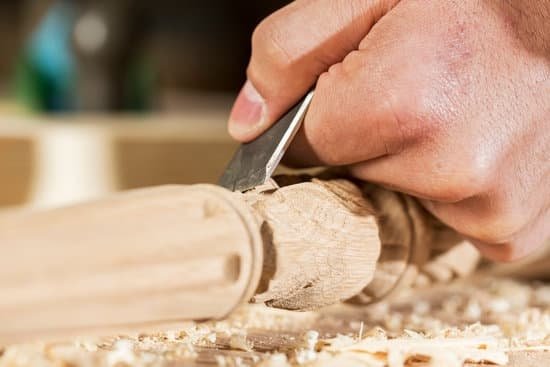Woodworking is a craft that has been practiced for centuries to create beautiful and functional objects from wood. One essential tool that every woodworker should have a solid understanding of is the lathe. A lathe is a versatile machine that allows woodworkers to shape and transform raw pieces of wood into various forms, such as bowls, spindles, and furniture legs.
In this article, we will explore the importance of understanding the lathe in woodworking. We will delve into its origins and history, tracing back its use to ancient times. Understanding the basic principles and functionality of a lathe is crucial to harnessing its power effectively, so we will discuss how it works in detail.
Additionally, we will provide a comprehensive overview of the different types of lathes available in woodworking. Each type has its own unique features and capabilities, making it important for woodworkers to choose the right one for their projects. We will also highlight the essential components and accessories of a lathe, explaining their significance in achieving desired woodturning results.
By gaining an understanding of lathes in woodworking, woodworkers can unleash their creativity and explore various woodturning techniques with confidence. However, safety measures should always be prioritized when operating a lathe. We will provide valuable tips and precautions to follow to ensure a safe working environment.
So whether you are new to woodworking or an experienced craftsman looking to expand your skills, this article will serve as your comprehensive guide on understanding lathes in woodworking. From learning how to use a lathe step-by-step to exploring different woodturning techniques, we aim to equip you with the knowledge necessary for successful woodworking projects using this versatile tool.
Exploring the Origins and History of Lathes in Woodworking
The Early Origins of Woodturning
Woodturning, the technique of shaping wood using a lathe, has a rich and ancient history dating back thousands of years. The origins of woodturning can be traced back to ancient times when humans first started creating tools and objects from wood. Archaeological evidence suggests that woodturning was practiced in Ancient Egypt as early as 1300 BC.
During this time, the Egyptians used bow lathes, which were operated by a person pulling a bowstring attached to the workpiece. This centrifugal force allowed the wood to rotate, while cutting tools were used to shape it into various forms. The use of lathes in woodworking expanded beyond Egypt and reached other cultures like Greece and Rome.
Medieval Era and Advancements in Lathe Technology
In the medieval era, European craftsmen began using pedal-operated lathes. This innovation allowed for greater control over the rotation speed and revolutionized woodworking techniques. During this period, skilled turners created intricate designs by combining manual tool work with turning on a lathe.
One significant advancement during the Renaissance era was the invention of ornamental turning lathes. These specialized lathes featured mechanical attachments that enabled turners to create highly decorative designs on turned objects. Ornamental turning reached its peak during the 17th and 18th centuries and resulted in beautifully crafted items such as bowls, goblets, and boxes with intricate patterns.
The Industrial Revolution and Modern Lathes
The industrial revolution brought about significant advancements in lathe technology, making them more efficient and accessible for mass production purposes. In the late 18th century, steam-powered lathes emerged, allowing for improved precision and faster production rates.
The introduction of electricity in the late 19th century further revolutionized lathe design. Electric motors replaced steam engines, simplifying the operation and maintenance of lathes. These developments allowed woodturning to become more accessible to a wider audience and contributed to the growth of the woodworking industry.
Today, modern lathes utilize computer numerical control (CNC) technology, enabling highly precise and automated woodturning. Whether it’s a traditional pedal-operated lathe or a state-of-the-art CNC lathe, the evolution of lathes in woodworking has come a long way, resulting in endless possibilities for creativity and craftsmanship.
Understanding the Basic Principles and Functionality of a Lathe in Woodworking
A lathe is a fundamental tool in woodworking that is designed for shaping and sculpting wood into various shapes and sizes. Understanding the basic principles and functionality of a lathe is essential for any woodworker, whether they are a novice or an experienced professional. This section will delve into how a lathe works, providing a comprehensive understanding of its mechanics.
Rotation
At its core, a lathe operates by rotating the wooden workpiece on its axis while a cutting tool remains stationary or moves along the piece to shape it. The rotation can be achieved either manually, by hand-cranking the workpiece, or with the help of an electric motor. This rotational motion allows for precise control over the shaping process and ensures consistent results.
Lathe Components
To understand how a lathe works, it’s essential to familiarize oneself with its key components. The bed is the foundation of the lathe where the workpiece rests and rotates. The headstock houses the motor responsible for powering the rotation, while the tailstock provides support to one end of the workpiece. The tool rest is positioned above the bed and supports various cutting tools used to shape the wood.
Cutting Tools
The cutting tools used in a lathe are crucial for achieving desired shapes and textures on the wood. Chisels, gouges, scrapers, and skew chisels are common types of cutting tools employed in woodworking lathes. Each tool serves a different purpose and offers versatility in creating intricate designs.
By understanding how these components work together, woodworkers can harness the power of a lathe to create stunning pieces of craftsmanship. Whether it’s turning bowls, crafting spindles, or adding decorative elements to furniture, mastering the basic principles of a lathe unlocks endless creative possibilities in woodworking projects.
Different Types of Lathes in Woodworking
Benchtop Lathe
One type of lathe commonly used in woodworking is the benchtop lathe. As the name suggests, this type of lathe is designed to be placed on top of a bench or table. Benchtop lathes are typically smaller and more compact compared to other types, making them suitable for hobbyists or those with limited space. They are great for turning smaller projects such as pens, chess pieces, or small bowls.
Mini Lathe
Similar to benchtop lathes, mini lathes are also compact in size but designed specifically for even smaller projects. These lathes are often portable and lightweight, making them ideal for woodworkers who need to move their equipment around frequently or have limited workspace. Mini lathes are popular among woodturners who focus on creating intricate details and delicate pieces.
Full-Size Lathe
On the other end of the spectrum, full-size lathes are larger and more powerful machines used for handling bigger projects. They have greater swing capacity and can accommodate longer pieces of wood. Full-size lathes are commonly found in professional woodworking shops or studios where large-scale turning is required. These lathes offer increased stability and precision, enabling woodworkers to create larger bowls, vases, furniture legs, or even baseball bats.
CNC Lathe
With advancements in technology, computer numerical control (CNC) lathes have become increasingly popular among woodworkers. These automated machines utilize computer programming to control the movement and operation of the lathe. CNC lathes allow for highly precise and complex designs that would be difficult to achieve manually. While they require specialized knowledge and training to operate, they offer unparalleled accuracy and repeatability in woodworking projects.
No matter which type of lathe you choose, it is important to consider your specific woodworking needs, available space, and skill level. Each type of lathe has its own advantages and limitations, so it’s crucial to thoroughly research and understand the different options before making a decision.
Essential Components and Accessories of a Lathe
In order for a lathe to function properly and produce quality woodworking projects, there are several essential components and accessories that play crucial roles. Understanding the significance of these components and accessories is important for woodworkers who want to maximize their lathe’s capabilities.
One of the key components of a lathe is the bed. The bed is the main frame of the lathe and provides stability and rigidity. It typically has a flat, horizontal surface on which the other components are mounted. The length of the bed determines the maximum length of wood that can be turned on the lathe. For larger projects, such as table legs or balusters, a longer bed is necessary.
Another important component of a lathe is the headstock. This is where the motor is located, which provides power to rotate the workpiece. The headstock also contains a spindle that holds various accessories such as chucks or faceplates. The size and power of the motor in the headstock will determine how large and heavy a piece of wood can be turned on the lathe.
Along with these main components, there are several accessories that expand the capabilities of a lathe. One common accessory is a chuck, which holds onto the workpiece securely while it spins. Chucks come in various sizes and configurations to accommodate different types of turning projects. Faceplates are another accessory that allows woodturners to attach workpieces directly to them for shaping.
Other essential accessories include tool rests, which support cutting tools while they shape or carve wood, and tailstocks, which provide additional support for longer workpieces during turning. Additionally, live centers and drive centers are used to secure workpieces between them and allow for smooth rotation.
Understanding these essential components and accessories not only helps woodworkers make informed decisions when purchasing or upgrading their lathes but also enhances their understanding of how a lathe works. By utilizing the right components and accessories, woodworkers can achieve greater precision, stability, and versatility in their woodworking projects.
Safety Measures
Woodworking can be an enjoyable and rewarding hobby, but it also comes with its fair share of risks. When operating a lathe in woodworking, it is crucial to prioritize safety measures to prevent accidents and injuries. This section will provide you with essential tips and precautions to follow while using a lathe.
- Use Protective Gear: Before starting any woodworking project that involves a lathe, always ensure you are wearing the appropriate protective gear. This includes safety glasses or goggles to protect your eyes from flying debris, ear protection to guard against loud noises, and a dust mask or respirator to prevent inhalation of harmful wood dust.
- Secure the Workpiece Properly: A loose workpiece can result in dangerous vibrations or can be ejected from the lathe altogether. Ensure that your workpiece is securely fastened in place using clamps, screws, or other proper securing methods. Take time to make sure everything is tight and stable before starting the lathe.
- Maintain a Safe Working Distance: Always maintain a safe distance between your body and the spinning workpiece on the lathe. It is recommended to keep at least six inches away from the rotating material at all times. This precaution will minimize the risk of getting caught in any moving parts.
- Keep Hands Away from Moving Parts: Never attempt to touch, adjust, or remove chips or debris while the lathe is operating. Always wait for the machine to come to a complete stop before making any adjustments or cleaning out waste materials.
| Tips | Precautions |
|---|---|
| Use protective gear | Maintain a safe working distance |
| Secure workpiece properly | Keep hands away from moving parts |
Remember, safety should always be the top priority when using a lathe in woodworking. By following these tips and precautions, you can minimize the risk of accidents and create a safe working environment for yourself and others.
Step-by-Step Guide on How to Use a Lathe in Woodworking
A lathe is a versatile tool used in woodworking to shape and form wood into various intricate designs. Understanding how to properly use a lathe is crucial for woodworkers who want to create beautiful and functional pieces. In this section, we will provide a step-by-step guide on how to use a lathe in woodworking.
- Safety First: Before starting any work on the lathe, it is important to prioritize safety. Wear appropriate personal protective equipment such as safety glasses, ear protection, and a dust mask. Make sure that the lathe is stable and securely mounted to prevent any accidents or injuries.
- Set Up the Lathe: Begin by setting up the lathe according to the manufacturer’s instructions. Ensure that the tool rest is at the correct height and distance from the spinning workpiece. Adjust the speed of the lathe depending on the size and type of wood being used.
- Choosing and Mounting the Wood: Select a piece of wood that is suitable for your project. It should be securely mounted between centers or on a faceplate using screws or a chuck. Make sure that it is centered and balanced to avoid any vibrations or wobbling during turning.
- Start Turning: Turn on the lathe and allow it to reach full speed before bringing your tools near the spinning wood. Use gouges, chisels, scrapers, or other appropriate turning tools to shape and remove material from the wood as desired. Take light cuts gradually rather than deep cuts all at once for better control.
- Finish and Sanding: Once you have achieved your desired shape, finish off by sanding down the surface of the wood using sandpaper or sanding pads in progressively finer grits for a smooth result.
- Applying Finish: After sanding, apply your preferred finish such as varnish, oil, wax, or paint depending on your project requirements. Allow sufficient drying time before handling or further refinement.
- Clean Up: Turn off the lathe and clean up any wood chips, dust, or debris that may have accumulated during the turning process. Properly store your tools and equipment in a designated area.
This step-by-step guide provides a basic understanding of how to use a lathe in woodworking. It is important to practice proper techniques and safety precautions while working with a lathe to ensure successful and enjoyable woodworking projects.
Exploring Various Woodturning Techniques
Woodturning is a technique that involves shaping wood using a lathe machine. It allows woodworkers to create intricate designs and smooth finishes on their projects. In this section, we will explore some of the various woodturning techniques that demonstrate the versatility of a lathe in woodworking.
- Spindle Turning: This technique is commonly used to create cylindrical or tapered shapes such as table legs, chair spindles, or even baseball bats. The wood is mounted between the headstock and tailstock of the lathe, and then shaped using gouges or chisels. It requires precision and control to achieve smooth curves and consistent dimensions.
- Bowl Turning: This technique involves turning a block of wood into a hollowed-out bowl shape. The process starts by mounting the wood blank on a faceplate or chuck attached to the headstock. The exterior shape is then carved using gouges and other tools while the interior is hollowed out using specialized hollowing tools. Bowl turning allows woodworkers to showcase the natural beauty of the wood grain and create functional pieces.
- Ornamental Turning: For those looking for more intricate and decorative designs, ornamental turning is an excellent choice. This technique involves creating complex patterns and textures on wood surfaces using specific cutting tools called ornamental turning attachments. With these attachments, woodworkers can produce intricate engravings, spirals, flutes, and other embellishments that add visual interest to their projects.
- Faceplate Turning: Faceplate turning is often used for creating large or irregularly shaped objects like platters or bowls with natural edges. The piece of wood is attached directly to the faceplate mounted on the headstock of the lathe without using a tailstock for support. This technique allows for greater freedom in shaping and designing unique pieces.
Regardless of the specific technique used, it’s essential to practice proper safety measures when working with a lathe in woodworking projects. Always wear appropriate safety gear such as goggles, a face shield, and gloves to protect yourself from flying debris. Additionally, familiarize yourself with the lathe’s controls and follow proper operating procedures to avoid accidents.
By mastering these woodturning techniques, woodworkers can unlock the full potential of a lathe in their woodworking projects. Whether it’s creating functional items like table legs or decorative pieces with intricate designs, a lathe provides endless possibilities for creativity and craftsmanship.
Recommended Lathe Models for Different Skill Levels
Choosing the right lathe is crucial for woodworkers of all skill levels. The right equipment can enhance productivity, accuracy, and safety in woodworking projects. In this section, we will explore recommended lathe models for different skill levels to help woodworkers make an informed decision.
For beginners or hobbyists who are just starting their woodworking journey, a mini lathe is often recommended. These lathes are compact and affordable, making them ideal for those who have limited space or budget. Mini lathes are also user-friendly and typically have lower horsepower, which allows beginners to practice and learn without overwhelming power or complex features.
As woodworkers gain experience and confidence, they may want to upgrade to a mid-sized lathe. Mid-sized lathes offer more power, larger capacities, and additional features compared to mini lathes. They provide the versatility needed for more advanced turning projects while still being manageable for intermediate woodworkers.
For professional woodworkers or experienced enthusiasts who regularly tackle large-scale projects, a full-sized lathe is the recommended choice. Full-sized lathes offer the highest power capacity and largest work surface area. They are designed to handle heavy-duty turning tasks with ease and precision. These lathes often come with advanced features such as variable speed control and electronic controls for enhanced customization.
It is important for woodworkers to carefully consider their current skill level and future aspirations when selecting a lathe model. Choosing the right lathe can significantly impact the quality of their work and overall woodworking experience. By assessing their needs and goals, woodworkers can make an informed decision that aligns with their desired outcomes.
Common Troubleshooting and Maintenance Tips for Lathe Owners
Owning a lathe in woodworking requires regular maintenance to ensure its longevity and efficiency. By following these common troubleshooting and maintenance tips, lathe owners can keep their equipment in optimal condition and avoid costly repairs or replacements.
Cleaning and Lubricating
Regular cleaning is essential for maintaining the functionality of a lathe. Sawdust, wood chips, and other debris can accumulate over time and affect the smooth operation of the machine. Use compressed air or a vacuum cleaner to remove any buildup from the lathe’s surfaces, crevices, and moving parts.
In addition to cleaning, proper lubrication is crucial to prevent friction and wear on various components. Refer to the manufacturer’s recommendations for the appropriate lubricants and intervals for application. Pay attention to bearings, shafts, gears, and other areas that require lubrication.
Checking Alignment
Ensuring that your lathe is properly aligned is important for achieving accurate results in your woodworking projects. Periodically check the alignment of the headstock, tailstock, tool rest, and banjo using precision measuring tools such as calipers or a dial indicator.
If you find any misalignment issues, consult your lathe’s user manual for instructions on how to adjust or realign them. Properly aligned components will not only improve your turning results but also extend the life of your lathe.
Inspecting Belts and Cables
Check the condition of belts and cables regularly to identify signs of wear or damage. Over time, belts may become loose or develop cracks due to prolonged use. Cables can also fray or become damaged from sharp edges or improper handling.
When inspecting belts, ensure they are correctly tensioned according to the manufacturer’s recommendations. Replace any worn-out belts or cables promptly with suitable replacements.
By following these troubleshooting and maintenance tips diligently, lathe owners can extend the life of their equipment and maintain its efficiency. Regular cleaning, lubrication, alignment checks, and inspections of belts and cables will help ensure a smooth woodworking experience with accurate results.
Conclusion
In conclusion, understanding the importance of a lathe in woodworking is crucial for any woodworker. Throughout history, lathes have played a significant role in shaping and creating intricate designs on wood. By exploring the origins and history of lathes, we can appreciate the craftsmanship that has been passed down through generations.
With a clear understanding of the basic principles and functionality of a lathe, woodworkers can harness its power to transform raw pieces of wood into beautiful objects. The different types of lathes available provide options for various woodworking projects, from small hobbyist creations to large-scale professional ventures.
Moreover, knowing the essential components and accessories of a lathe ensures that woodworkers have all the necessary tools to achieve their desired results. Safety measures should always be followed to prevent accidents and ensure the well-being of the user. By following a step-by-step guide on how to use a lathe and exploring different woodturning techniques, woodworkers can unleash their creativity and explore the versatility of this invaluable tool.
For those looking to invest in a lathe, it is important to choose the right model for their skill level. Recommendations for different skill levels can help beginners get started and experts upgrade their equipment as they progress in their craft. Finally, regular maintenance and troubleshooting tips will ensure that lathe owners can enjoy its longevity and efficiency for years to come.
Frequently Asked Questions
What is a lathe in simple terms?
A lathe is a type of machine tool that is used to shape and cut materials such as metal or wood. It consists of a rotating workpiece and a cutting tool, which is held by the machine and moved against the workpiece to remove unwanted material.
The workpiece is typically secured in place and rotated while the cutting tool creates the desired shape or cut.
Which lathe is used for woodworking?
The lathe commonly used for woodworking purposes is known as a wood lathe. Wood lathes are specifically designed for shaping and turning wooden pieces.
They have certain features that make them ideal for working with wood, such as adjustable speed controls, sturdier construction, and specialized attachments like faceplates or chucks that securely hold the wooden workpiece in place while it rotates.
What is the difference between a lathe and a wood lathe?
While both lathes are fundamentally similar in their function of shaping materials through rotation, the main difference between a lathe and a wood lathe lies in their intended use and design features. A lathe is a broad term that encompasses various types used across multiple industries for shaping different materials such as metal, while a wood lathe specifically caters to woodworking needs.
Wood lathes often have larger capacities for handling larger wooden pieces than general-purpose lathes. They may also feature specialized tools, attachments, or accessories tailored to woodworking tasks that are not commonly found on standard lathes meant for multiple materials.

Hi everyone! I’m a woodworker and blogger, and this is my woodworking blog. In my blog, I share tips and tricks for woodworkers of all skill levels, as well as project ideas that you can try yourself.





